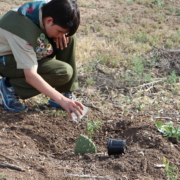DTE Energy | An Urban Oasis for Community and Wildlife in Industrial Detroit
En Español
A power plant in an industrial area of Detroit at the juncture of the Rouge and Detroit Rivers is hardly the place one ventures for a retreat to nature. But a team of employee volunteers at DTE Energy have created an urban oasis at the company’s 105-acre River Rouge Power Plant.
Determined to utilize unused space amidst a sea of buildings and pavement, the team prioritized the incorporation of habitat wherever possible on the property, replacing every square inch of lawn with native, wildlife-friendly vegetation and creating a 5-acre nature area, repurposed from an unused, mowed field. Here, employees and visitors alike can enjoy and learn about the abundant tree plantings, prairie habitat, ponds and trails.
Great care was taken with the choices of landscape and species to ensure they were native to the region and beneficial to existing wildlife, according to Kirsten LeForce, DTE Energy conservation programs coordinator. The native plantings of trees, grasses and flowers include a variety of species that provide food for migrating birds, which stop over at the site in large numbers each spring and fall. The nature area also features a snake hibernaculum which provides cover habitat for Michigan state-threatened eastern fox snakes.
From the beginning, the nature area was meant to be enjoyed not only by employees but also the surrounding community, which lacked a useable source of greenspace. The River Rouge Power Plant hosts events several times a year, inviting local elementary schools and other community groups to participate in nature walks along the trails, tree planting, invasive species removal, pond sampling, and educational presentations about Michigan’s animals.
Another priority was the shoreline since the area was in dire need of restoration. In an effort to attract native birds and fish, the team received a Five Star Restoration Grant in 2010 to implement soft-shore engineering along the hardened Rouge River shoreline. This successfully-restored area now provides valuable habitat for herons and fish, and the native vegetation prevents the shoreline from eroding any further. The team also attempted to create nesting habitat for state-threatened common terns along the shoreline. However, despite working with several experts and utilizing best-practice tactics to attract terns, these birds have not yet successfully nested on-site. Jason Cousino, the Wildlife Habitat Coordinator for the River Rouge facility, noted that no matter how much time, energy and excitement goes into a project, it still may not be successful, but important lessons can be learned from failures just as much as successes.
Above all, LeForce remarked that the employees’ “passion for their site” is what drives the program’s continued success. Employees from all levels can get involved with the projects that are important to them, and the team receives an abundance of support from site management for implementing and maintaining projects.
Related Content
- Blogs
- The Greening of Detroit – How DTE Energy and GM are Helping to Restore Nature in America’s Comeback City
- Grow It, Don’t Mow It!
- The Kestrel and the Steel Mill – How the Urban Industrial Landscape Can Support Climate, Community and Habitats
- A Hands-On Approach to Building the STEM Workforce of Tomorrow
- Back to School: Partnering with Local Schools to Strengthen Your Certification Program
- Habitat Design that Invites Exploration
- Wildlife in Winter: Migration
- What’s All the Fuss About Native Plants?
- Webinars:
- Project Guidances:
- Avian
- Grasslands
- Formal Learning
- Awareness and Engagement
- White Papers:
Quick Facts
| Site Name: | River Rouge Power Plant |
|---|---|
| Category: | Member Spotlight |
| Tags: | avian, Awareness and Community Engagement, Education & Awareness, formal learning, grasslands, habitat, pollinators, Species Management |
| Site Locations: | Detroit, Michigan, Michigan |
| Partners: | Beacon Day Treatment Center, Boy Scouts, Michigan Department of Natural Resources, Wayne State University |
| Certification Since: | 2004 |
| WHC Index Link: | Learn more about this program |




